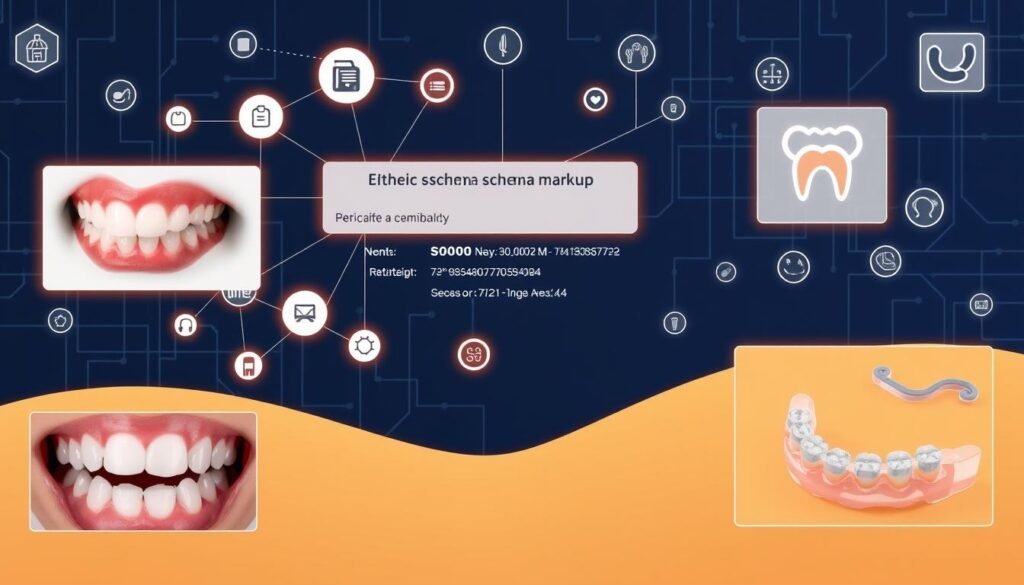Did you know over 75% of patients start looking for an orthodontist online? Today, the digital world is key to your practice’s success. SEO is essential for orthodontists to draw in and keep patients. By learning SEO, you can make your practice more visible online, get more qualified leads, and grow your business.
At Macro Webber, we know the digital challenges and chances orthodontists face. We’re a top digital marketing agency that has helped many orthodontic practices in the U.S. reach their goals with our SEO solutions. We offer everything from keyword optimization to local SEO expertise to help you.
Key Takeaways for Successful Orthodontist SEO
- Optimize your website with targeted keywords to improve search engine rankings
- Leverage local SEO strategies to attract patients in your geographic area
- Enhance user experience through mobile optimization and content clarity
- Build a strong online presence and authority with high-quality backlinks
- Leverage schema markup and voice search optimization to capture new opportunities
Introduction to Orthodontist SEO Strategies
In today’s digital world, being seen online means being found by potential patients. Search engine optimization (SEO) plays a big role in this. It helps your orthodontic practice show up more online, making your website more visible. With 82.8% of people using search engines to find healthcare providers in 2023, a strong SEO strategy is key to drawing in more patients.
Why Orthodontists Need SEO
SEO for orthodontists is very important. Orthodontic digital marketing and Google rankings for orthodontists depend on it. By making your website and online presence better, you can climb up the search engine rankings. This makes it easier for people to find your orthodontic services.
Key Takeaways for Successful Orthodontist SEO
- Do thorough keyword research to find the best terms for your practice.
- Use both general and specific orthodontic-related keywords to reach more searches.
- Put these keywords in your website’s content, URLs, and meta tags for better orthodontic website optimization.
- Work on making your site fast, mobile-friendly, easy to navigate, and clear to improve search rankings.
- Build a strong local SEO plan, including optimizing your Google Business Profile and listing in local directories, to draw in nearby patients.
By using these SEO strategies for orthodontists, you can make your practice more visible online. This will help you attract more patients and grow your practice in the digital age.
Mastering Keyword Optimization for Orthodontic Websites
For orthodontist SEO, where you put your keywords is as important as what keywords you choose. Using clear and descriptive URLs, meta tags, and headers with the right keywords can really help you stand out in search results. It’s key to make your title tags and meta descriptions include the keywords that match what users are looking for. Remember, keep these tags short for the best display on all devices.
Using header tags smartly can make your content easier to read and understand. This helps both your visitors and search engines.
Beyond Basic Search Terms
Going for long-tail keywords can help you catch the specific searches people do. These longer phrases can bring more targeted traffic to your site, leading to more qualified leads. For voice search, make sure your content includes these longer, question-like keywords. This matches how people talk when using voice search.
Keep an eye on SERP features like featured snippets and ‘People also ask’ sections. A lot of voice search answers come from these spots.
Tools of the Trade
Doing good keyword research is key for a strong orthodontist’s SEO strategy. Tools like SEMrush, Moz Keyword Explorer, Google’s Keyword Planner, and Ubersuggest help by showing new keywords, how often they’re searched, trends, and who’s competing. AnswerThePublic shows what questions people might have, helping orthodontists understand their patients better.
| SEO Tool | Key Benefits |
|---|---|
| SEMrush | Comprehensive keyword research, competitor analysis, and SERP tracking |
| Moz Keyword Explorer | In-depth keyword research, including search volume and difficulty metrics |
| Google Keyword Planner | Free keyword research tool from Google, providing search volume and trend data |
| Ubersuggest | Keyword research, competitor analysis, and website auditing |
| AnswerThePublic | Visualizes search query data, highlighting common user questions and concerns |
“Effective keyword research is the foundation of any successful orthodontist SEO strategy.”
Enhancing User Experience for Better Rankings
In today’s smartphone world, having a mobile-friendly orthodontist website is key for better online visibility and rankings. Search engines, like Google, look for websites that work well on mobile. A responsive design for orthodontic practices means your site changes size to fit any screen, giving a great experience to potential patients.
Mobile Optimization in the Era of Smartphones
Most patients use smartphones to find orthodontic services. So, your website must be mobile-first and mobile-friendly. This makes the site better for users and follows Google’s mobile-first indexing rules, which favors sites made for mobile.
Core Web Vitals as a Ranking Signal
Google’s Core Web Vitals are now key for orthodontist website rankings. They check how fast a page loads, how interactive it is, and how stable it looks. Improving your Core Web Vitals for orthodontist websites means better page speed optimization for orthodontic practices and visual stability for orthodontic websites. This can help you rank higher in search engines.
Google’s Page Speed Insights is a tool to check your website’s Core Web Vitals. It shows where you can get better, like making images smaller, reducing CSS and JavaScript, and improving mobile-friendly orthodontist website design.
“Enhancing the user experience is a cornerstone of successful SEO for orthodontists. By optimizing for mobile and addressing Core Web Vitals, you can establish a strong online presence and outrank your competitors.”
Navigation and Content Clarity
Making an orthodontic website more than just good-looking is about creating a smooth experience. It should guide visitors easily through your content. From the start, clear navigation and a well-organized content hierarchy keep them interested and help them book an appointment.
Breadcrumb navigation is a key part of a good website structure. These trails at the top of pages act like digital breadcrumbs. They help users know where they are and make it easy to go back to main pages. This improves the user experience and helps your orthodontic website’s SEO.
- Make navigation menus easy to use so visitors can find what they need quickly.
- Organize your content clearly, with links to related topics.
- Use breadcrumb navigation to help users understand your site’s layout and move between pages easily.
By focusing on navigation and making content clear, you can make an orthodontic website that looks good and works well. This leads to more patient inquiries and bookings for your practice.
“A well-structured website is like a well-organized house – it’s easier for visitors to find what they’re looking for.”
Local SEO Mastery for Orthodontists
As an orthodontist, you focus on making smiles better and helping patients with their oral health. But, to keep getting new patients, you need to be good at local search engine optimization (SEO). Local SEO helps people in your area find you.
Unlock the Power of Google My Business Optimization
Your Google My Business (GMB) profile is often the first thing people see when they look for an orthodontist near them. Making this profile better can really help you stand out online. Make sure your GMB listing is full, right, and interesting. Use good photos, share all the details about your business, and show off positive reviews from patients.
Embrace Local Citation Building
Being listed on trusted local directories and citations can also boost your online presence. Claim and make the most of your listings on sites like Yelp, Yellow Pages, and local business websites. Keeping your name, address, and phone number the same everywhere will help you rank better in local searches.
Leverage Localized Keywords
For local SEO, using the right keywords is key. Add terms like ‘orthodontist in [city]’ or ‘best orthodontist near me’ to your website, meta descriptions, and titles. This makes you more likely to show up in searches for your area.
Mastering these local SEO tips will draw more patients to you, making you the top choice in your area. A strong online presence is crucial for a successful orthodontic practice.
search engine optimization for orthodontists
As an orthodontist, having a strong online presence is key to getting new patients and growing your practice. That’s where search engine optimization (SEO) comes in. By using orthodontist SEO strategies, you can make your practice more visible on search engines. This means more organic website traffic and being seen as a trusted dental care expert.
At Macro Webber, we know the challenges and chances for orthodontic practices. Our experts create a online marketing for orthodontic practices plan just for you. We focus on your goals and who you want to reach.
- Keyword Optimization: Finding the right keywords is key for orthodontist SEO. We’ll find and use the best search terms in your website and other places.
- Content Creation: Good content helps your search rankings. We’ll make blog posts, service pages, and more that your patients will like.
- Local SEO: Your practice’s local visibility is important. We’ll make your online listings better and help you show up in local searches.
- Technical Optimization: Fast websites and being mobile-friendly are important to search engines. We’ll make your site better for users and improve your SEO.
“Macro Webber has been a game-changer for our orthodontic practice. Their orthodontist SEO strategies have helped us rank higher, attract more qualified leads, and grow our patient base significantly.”
– Dr. Sarah Wilson, Orthodontist
Want to boost your orthodontic practice? Contact Macro Webber today. Let us use search engine optimization to help you grow and succeed over time.

Building Backlinks and Online Authority
In the world of SEO, building backlinks and online authority is key for orthodontists. By using smart link building for orthodontist websites, you can boost your practice’s visibility. This makes your content marketing for orthodontists a go-to resource in your field.
Search engines like Google value a website’s trustworthiness when ranking it. Getting backlinks from other reputable sites tells search engines your content is valuable. The more quality backlinks you get, the stronger your site’s authority becomes. This leads to better visibility and more patient leads.
But, link building takes time and effort. It’s about creating content that others want to share. By making informative blog posts, engaging videos, or insightful industry pieces, you can draw attention. This encourages other site owners to link back to your practice.
While waiting for backlinks, focus on internal linking within your site too. This makes it easier for visitors to move around your site. It also keeps them on your site longer, which helps build your online authority.
| Strategies for Building Backlinks | Benefits of Improved Online Authority |
|---|---|
|
|
By using a solid link building for orthodontist websites strategy, you can boost your online authority for orthodontic practices. This will help your content marketing for orthodontists reach more people and bring in more patients.
Voice Search and FAQ Content Optimization
Voice search is big now, and orthodontists need to pay attention. To get ahead, use long-tail, question-style keywords that match how people talk when they search with their voices. Keywords like “how to find the best orthodontist near me” or “what are the benefits of orthodontic treatment” can help you connect with people looking for answers on voice-activated devices.
It’s also key to focus on SERP features like featured snippets and ‘People also ask’ sections. These often give voice search answers. By making FAQ content that answers common patient questions, you can boost your site for voice search and help users find what they need.
- Identify common questions and concerns that your patients have about orthodontic treatment.
- Craft informative, easy-to-understand FAQ content that directly answers these questions.
- Incorporate question-based keywords throughout the FAQ content to optimize for voice search.
- Ensure that your FAQ content is structured in a clear and concise manner, making it easy for users to find the information they need.
| Voice Search Optimization for Orthodontists | FAQ Content for Orthodontic Websites |
|---|---|
|
|
By focusing on voice search and creating great FAQ content, you can improve your online presence. This helps you reach more potential patients and give them the info they need. The secret is to know your audience and give them what they’re looking for.
Leveraging Schema Markup for Rich Results
Schema markup is a key tool for boosting your orthodontic practice’s online presence. It’s a structured data format that gives search engines detailed info about your site. This leads to more rich results and enhanced listings in search engine results pages (SERPs).
Using schema markup for orthodontist websites helps search engines understand your webpages better. This can show informative snippets like review ratings and location details right in the search results. It makes your practice more visible and builds trust with potential patients.
Structured data optimization for orthodontists can change the game for your online presence. Schema markup can increase clicks, engagement, and conversions for your practice. It’s a key part of a strong SEO strategy for orthodontist websites.
“Implementing schema markup is one of the most effective ways to stand out in the search results and capture the attention of potential patients.” – Macro Webber, SEO Strategist at Macro Webber
Don’t let your orthodontic practice get lost in the crowd. Optimize your site with schema markup to unlock the power of rich results for orthodontic practices. It’s a great way to boost your online visibility and draw in the right patients.

Tracking and Analyzing SEO Performance
To grow your orthodontic practice, it’s key to watch and study your SEO performance closely. By looking at orthodontist SEO metrics, you can see how well your online marketing is doing. This helps you make smart choices to improve your strategy.
Using tools like Google Analytics and Google Search Console, orthodontists can check their website’s SEO analytics for dental practices. These tools offer lots of data. You can see organic traffic, keyword rankings, conversion rates, and return on investment (ROI).
- Look at how much organic traffic your site gets and its trends over time. This shows how well your data-driven SEO strategies for orthodontists are working. It also points out what you can do better.
- Watch your keyword rankings and see how they change. This helps you make better content and optimize your site to match what people are searching for.
- Check your website’s conversion rates, like how many people book appointments or fill out forms. This tells you if your lead generation is working well.
- Figure out the ROI of your SEO efforts to see if they’re worth it. This helps you focus on the most profitable strategies.
By looking at these important metrics often, orthodontists can make smart choices. They can improve their SEO tactics and grow their practice sustainably. Use data to get ahead and draw in more patients online.
“Measure, analyze, and optimize. That’s the key to unlocking the true potential of SEO for your orthodontic practice.” – Macro Webber, Founder of Macro Webber
Conclusion
Using SEO can greatly improve your orthodontic practice’s online presence. It helps attract more qualified leads and increase patient numbers. SEO is a long-term strategy that takes time to show results. So, it’s key to stay consistent and patient.
By making your website better, you can show up more in search results. This helps you reach more people looking for orthodontic services near you. The guide has covered many SEO steps, from keyword research to improving user experience and using local SEO.
For deeper insights and more advanced SEO tips, think about talking to an SEO expert in orthodontics. The team at Macro Webber offers tailored solutions to help your practice grow online. With their help and your focus on great patient care, SEO can bring more patients to your office. This will make you the top orthodontist in your area.



